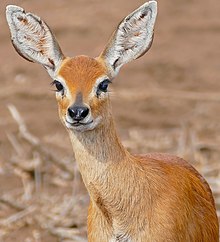| Raphicerus | |
|---|---|

| |
| Female steenbok | |
| Scientific classification | |
| Domain: | Eukaryota |
| Kingdom: | Animalia |
| Phylum: | Chordata |
| Class: | Mammalia |
| Order: | Artiodactyla |
| Family: | Bovidae |
| Subfamily: | Antilopinae |
| Tribe: | Neotragini |
| Genus: | Raphicerus H. Smith, 1827 |
| Type species | |
| Cerophorus acuticornis [1] de Blainville, 1816
| |
| Species | |
| Synonyms | |
|
Rhaphiceros Lydekker, 1897 | |
Raphicerus is a genus of small antelopes of the tribe Neotragini (subfamily Antilopinae).
Raphicerus is endemic to sub-Saharan Africa, ranging from Kenya in the north to the Western Cape in South Africa.
The genus contains three species:[2]
- Cape or southern grysbok R. melanotis
- Sharpe's or northern grysbok R. sharpei
- Steenbok R. campestris
References
[edit]- ^ Wilson, D. E.; Reeder, D. M., eds. (2005). Mammal Species of the World: A Taxonomic and Geographic Reference (3rd ed.). Johns Hopkins University Press. ISBN 978-0-8018-8221-0. OCLC 62265494.
- ^ Bisby F.A.; Roskov Y.R.; Orrell T.M.; Nicolson D.; Paglinawan L.E.; Bailly N.; Kirk P.M.; Bourgoin T.; Baillargeon G.; Ouvrard D. (red.) (2011). "Species 2000 & ITIS Catalogue of Life: 2013 Annual Checklist". Species 2000: Reading, UK. Retrieved 1 February 2014.
Well, that’s interesting to know that Psilotum nudum are known as whisk ferns. Psilotum nudum is the commoner species of the two. While the P. flaccidum is a rare species and is found in the tropical islands. Both the species are usually epiphytic in habit and grow upon tree ferns. These species may also be terrestrial and grow in humus or in the crevices of the rocks.
View the detailed Guide of Psilotum nudum: Detailed Study Of Psilotum Nudum (Whisk Fern), Classification, Anatomy, Reproduction